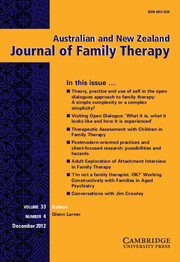Crossref Citations
This article has been cited by the following publications. This list is generated based on data provided by
Crossref.
Gavidia‐payne, Susana
Denny, Bianca
Davis, Kate
Francis, Andrew
and
Jackson, Merv
2015.
Parental resilience: A neglected construct in resilience research.
Clinical Psychologist,
Vol. 19,
Issue. 3,
p.
111.
Munns, Ailsa
Toye, Christine
Hegney, Desley
Kickett, Marion
Marriott, Rhonda
and
Walker, Roz
2018.
Aboriginal parent support: A partnership approach.
Journal of Clinical Nursing,
Vol. 27,
Issue. 3-4,
Askew, Deborah A.
Guy, Jillian
Lyall, Vivian
Egert, Sonya
Rogers, Lynne
Pokino, Leigh-anne
Manton-Williams, Peggy
and
Schluter, Philip J.
2019.
A mixed methods exploratory study tackling smoking during pregnancy in an urban Aboriginal and Torres Strait Islander primary health care service.
BMC Public Health,
Vol. 19,
Issue. 1,
Kickett-Tucker, Cheryl
and
Shahid, Shaouli
2019.
Handbook of Children and Prejudice.
p.
193.
Lilley, Rozanna
Sedgwick, Mikala
and
Pellicano, Elizabeth
2020.
Inclusion, acceptance, shame and isolation: Attitudes to autism in Aboriginal and Torres Strait Islander communities in Australia.
Autism,
Vol. 24,
Issue. 7,
p.
1860.
Ramsamy, Nicole
2021.
Yatdjuligin.
p.
187.
Fredericks, Bronwyn
and
Fergie, Doseena
2021.
Yatdjuligin.
p.
354.
Ward, Raelene
and
Fredericks, Bronwyn
2021.
Yatdjuligin.
p.
236.
Ward, Raelene
2021.
Yatdjuligin.
p.
307.
Lovett, Ray
and
Brinckley, Makayla-May
2021.
Yatdjuligin.
p.
34.
Fredericks, Bronwyn
Adams, Mick
and
Best, Odette
2021.
Yatdjuligin.
p.
104.
Drummond, Ali
Mills, Yoko
Mills, Sam
and
Nona, Francis
2021.
Yatdjuligin.
p.
81.
Smallwood, Gracelyn
2021.
Yatdjuligin.
p.
1.
Sherwood, Juanita
and
Geia, Lynore K.
2021.
Yatdjuligin.
p.
6.
Fredericks, Bronwyn
Best, Odette
and
Ward, Raelene
2021.
Yatdjuligin.
p.
121.
Ramsamy, Nicole
2021.
Yatdjuligin.
p.
169.
Wilson, Rhonda L.
and
Waqanaviti, Kristin
2021.
Yatdjuligin.
p.
281.
Best, Odette
and
Fredericks, Bronwyn
2021.
Yatdjuligin.
Kosiak, Machellee
2021.
Yatdjuligin.
p.
139.
Drummond, Ali
2021.
Yatdjuligin.
p.
207.


